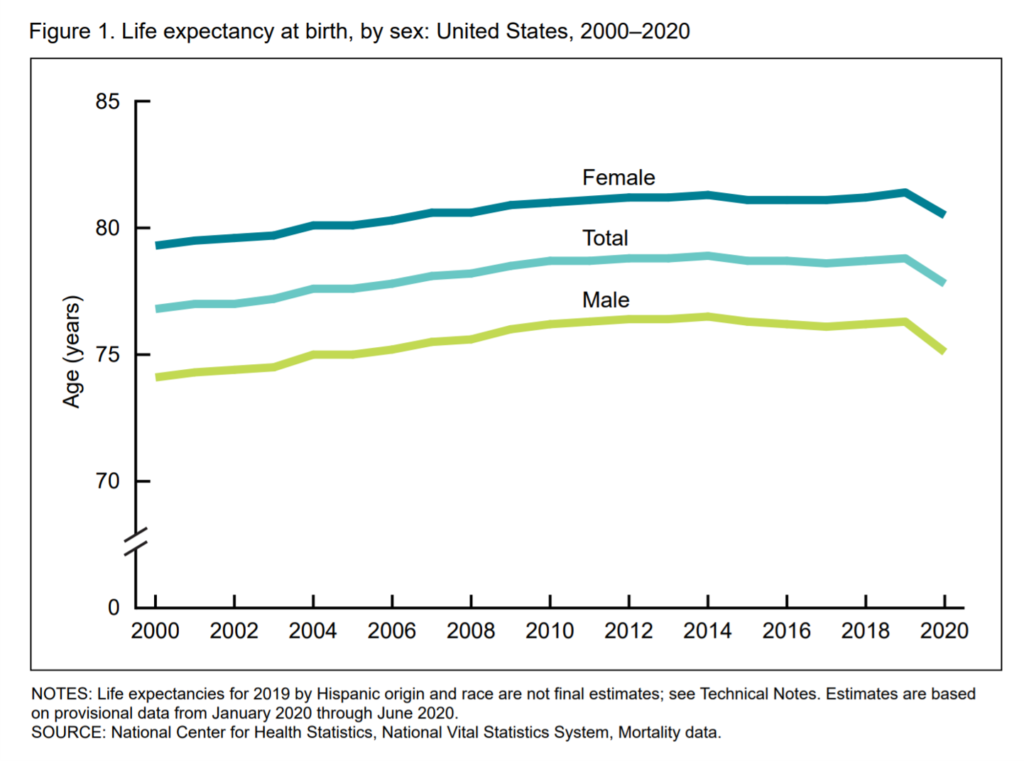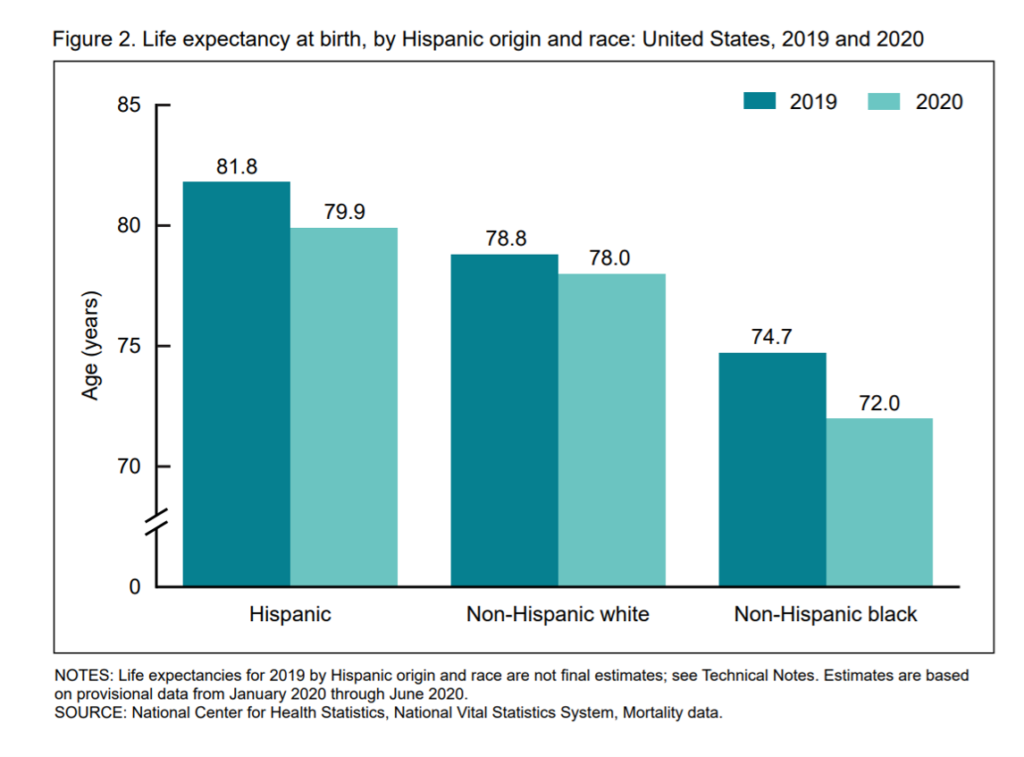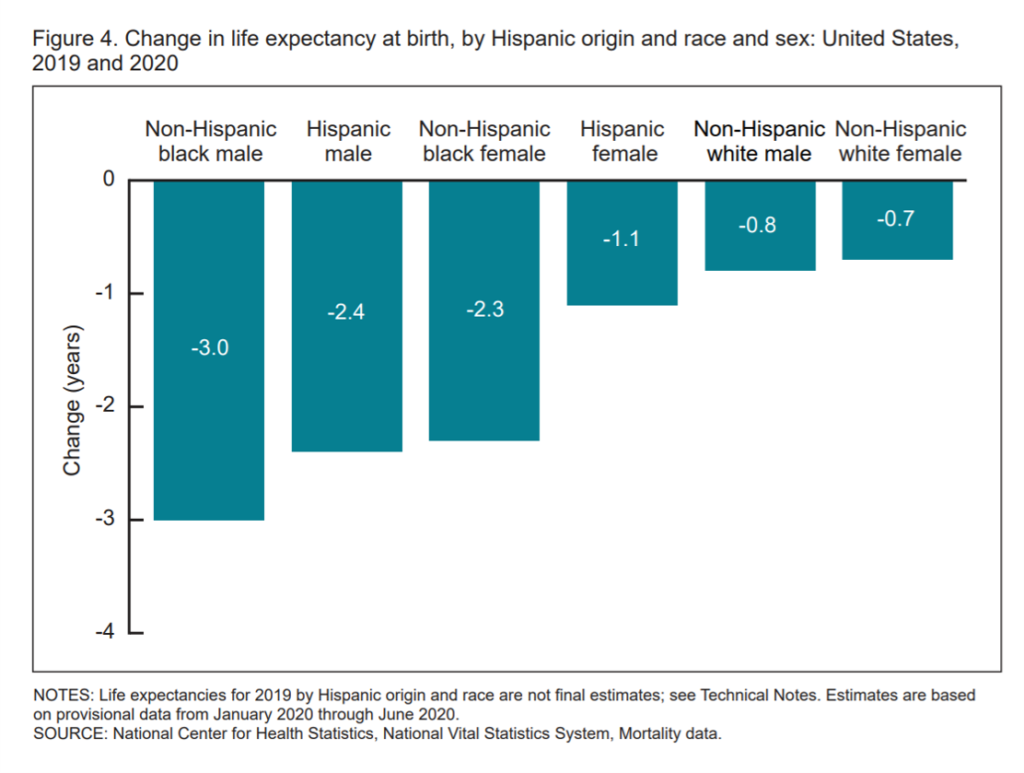Some people remark about 2020 being a “lost year” in the wake of the coronavirus pandemic.
 That happens to be a true statement, sadly not in jest: in the U.S., life expectancy at birth fell by one full year over the first half of 2020 compared with 2019, to 77.8 years.
That happens to be a true statement, sadly not in jest: in the U.S., life expectancy at birth fell by one full year over the first half of 2020 compared with 2019, to 77.8 years.
In 2019, life expectancy at birth was 78.8 years, according to data shared by the National Center for Health Statistics (NCHS), part of the Centers for Disease Control and Prevention (CDC).
Life expectancy at birth declined for both females and males, shown in the first chart.
The differences between males and females was 5.4 years in the first half of 2020, up from 5.1 in 2019.
It took years to narrow the life expectancy gender gap: NCHS notes that in the decade between 2000 and 2010, the gap between the sexes declined from 5.2 years to the lowest level of 4.8 years, then ticked up to 5.1 years in 2019. (For insights into that trend of growing male mortality, search for my posts on the Deaths of Despair here on Health Populi).

The are stark differences in life expectancy at birth based on a person’s race/ethnicity. If you were born black in 2020, you would on average have lost 2.7 years of future life compared with your peer-baby born in the first half of 2019.
Hispanic newborns lost 1.9 years of life expectancy based on this study.
These are striking gaps compared with newborn white babies who lost .8 years of longevity in 2020. That’s a near 2-year difference in life expectancy between Black newborns and White newborns.
Through another lens, the non-Hispanic white life expectancy advantage compared to the non-Hispanic black population grew from 4.1 to 6.0 years between 2019 and the first-half of 2020.
“Provisional life expectancy at birth in the first half of 2020 was the lowest level since 2006 for both the total population and for males, and was the lowest level since 2007 for females,” the report observes.
FYI, this reporting was the first time the NCHS has published life tables based on their provisional vital statistics data. Provisional data are early estimates based on death certificates that have been received, processed, and coded but not yet finalized by the NCHS. They are “provisional” because the NHCS may receive revised and additional death certificates up to 6 months after the end of 2020 (say, until June 2021).
 Health Populi’s Hot Points: Among the many disparities that COVID-19 has wrought and shone light on since the pandemic’s start has been its unequal and negative impact on people of color in the U.S. From job losses to exposure to the virus, certain under-treated pre-existing conditions exacerbating complications due to the coronavirus, or lack of connectivity to the Internet compromising peoples’ ability to work or attend school from home, COVID-19 has set back all layers of health for people of color – physical, mental/emotional, and financial.
Health Populi’s Hot Points: Among the many disparities that COVID-19 has wrought and shone light on since the pandemic’s start has been its unequal and negative impact on people of color in the U.S. From job losses to exposure to the virus, certain under-treated pre-existing conditions exacerbating complications due to the coronavirus, or lack of connectivity to the Internet compromising peoples’ ability to work or attend school from home, COVID-19 has set back all layers of health for people of color – physical, mental/emotional, and financial.
The Sum of Us, a new book by Heather McGhee, details the many flavors of inequities that put the U.S. national economy at-risk, all based in systemic racism whether people are seeking mortgages, college entrance and financial support for it, job entry, medical care, and other aspects of daily living that have resulted in lower financial health, less educational attainment, and poorer health outcomes.
Heather traveled America to unearth the details that, together, embody a myth of a zero-sum game that some people believe is real — that is, if one group succeeds, that takes away from another’s success.
Not true, Heather argues (and I agree): there’s a Solidarity Dividend that’s created as gains that come when people come together across race benefit every one.
That’s certainly true for health and health care access — COVID-19 has shown us. And we are all paying a price in life expectancy losses as a result, the NCHS data sadly demonstrates.
The post Americans Lost Future Life-Years in 2020: How Much Life Was Lost Depends on the Color of One’s Skin appeared first on HealthPopuli.com.
Americans Lost Future Life-Years in 2020: How Much Life Was Lost Depends on the Color of One’s Skin posted first on https://carilloncitydental.blogspot.com
No comments:
Post a Comment